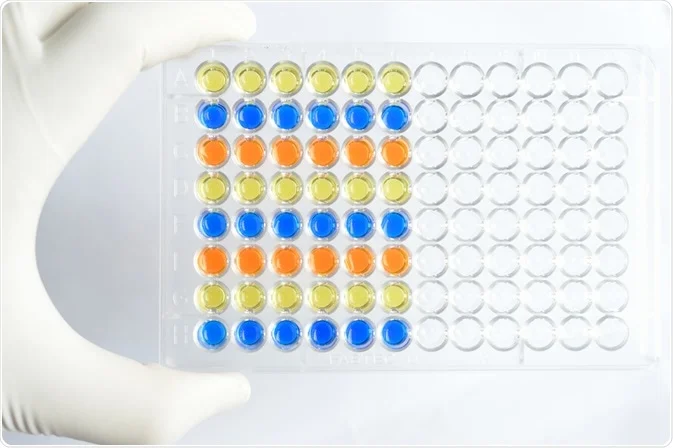The increasing demand for technologies to extract extensive bio-information from limited sample volumes has prompted the development of cost-effective, adaptable, and high-throughput methods for detecting multiple proteins simultaneously. A recent advancement in ELISA technology, the multiplex ELISA array, allows for the simultaneous measurement of multiple proteins within a single tissue sample. This innovation involves depositing multiple capture antibodies in a confined area, such as a single well or bead, reducing the required volume of tissue lysate. This advancement significantly reduces sample volume, time, labor, and material costs while enhancing sensitivity compared to single ELISA assays. Ultimately, it minimizes the need for patient serum in conducting comprehensive biological assays of multiple proteins.
Innovations in Multiplexed ELISA technologies
Multiplexed ELISA technology offers significant advantages. It allows simultaneous analysis of numerous analytes, sometimes hundreds, which is invaluable for comprehensive profiling or screening. Additionally, these assays require small sample volumes, which is ideal for scenarios with limited sample availability. Moreover, they provide a wide dynamic range and heightened sensitivity, ensuring accurate detection across diverse analyte concentrations. Furthermore, automated platforms reduce assay variability, enhance reproducibility, and streamline workflows, making them efficient tools for research and diagnostics.
Numerous multi-analyte detection arrays are available today, offering distinct advantages and applications. Planar arrays, for instance, encompass platforms like the Q–Plex™ array and the Mesoscale Discovery Platform (MSD®). These arrays comprise numerous immobilized high-affinity capture ligands on two-dimensional solid-phase support. Once immobilized, the ligands interact with the sample and are subsequently probed with detection antibodies. This methodology facilitates the concurrent detection of multiple analytes, offering researchers valuable insights into intricate biological systems.
Bead array assays employ capture beads as reaction centers, with each bead population linked to a specific capture antibody to capture the interested protein from the sample, following principles similar to sandwich ELISA. Detection of the captured analyte is accomplished using a biotinylated antibody that targets a secondary epitope of the protein. This methodology enables simultaneous detection of multiple analytes, serving as a powerful tool for comprehensive biomarker analysis. In Simoa® assays, analyte-bound beads can be readily isolated into separate wells and detected using fluorophores emitting unique wavelengths specific to the beads. In contrast, other bead-based technologies, like cytometric-based methods, retain a mixed suspension of analyte-bound beads during detection.
Flow cytometry-based bioanalysis employs particles with reaction sites illuminated by LED or laser light as they pass a detector. Luminex technology, a flow-based system, operates similarly to ELISA but uses fluorescent microspheres and detection antibodies for quantitative analysis. Different combinations of bead fluorescence wavelength and label indicate specific targets in the sample. Each capture antibody is linked to a microsphere emitting a unique wavelength. When the antigen is present, it binds to the capture antibody, forming a sandwich with the labeled detection antibody, which is fluorescently tagged. The Luminex system records bead fluorescence, providing quantitative target measurement.
Emerging multiplex immunoassays are entering the market without the need for any labeling. One such innovation is arrayed imaging reflectometry (AIR), an optical technique directly detecting antibody-antigen binding events. This method relies on changes in refractive index at the chip surface upon binding, resulting in a quantifiable light intensity increase. This label-free approach offers high sensitivity, selectivity, simplicity, and ease of use, positioning it as a promising option in multiplex immunoassays.
Many reliable bioanalytical laboratories offer bioanalysis services and ELISA development services tailored to support studies ranging from pre-clinical research to phase 3 trials. This encompasses a spectrum of tasks, from developing ELISA methods to ELISA validating and testing them. With a state-of-the-art ELISA laboratory, they can handle a diverse range of projects, including ELISA development, ELISA validation, MSD analysis, and verification of ELISA assays to guarantee the reliability and accuracy of results.


